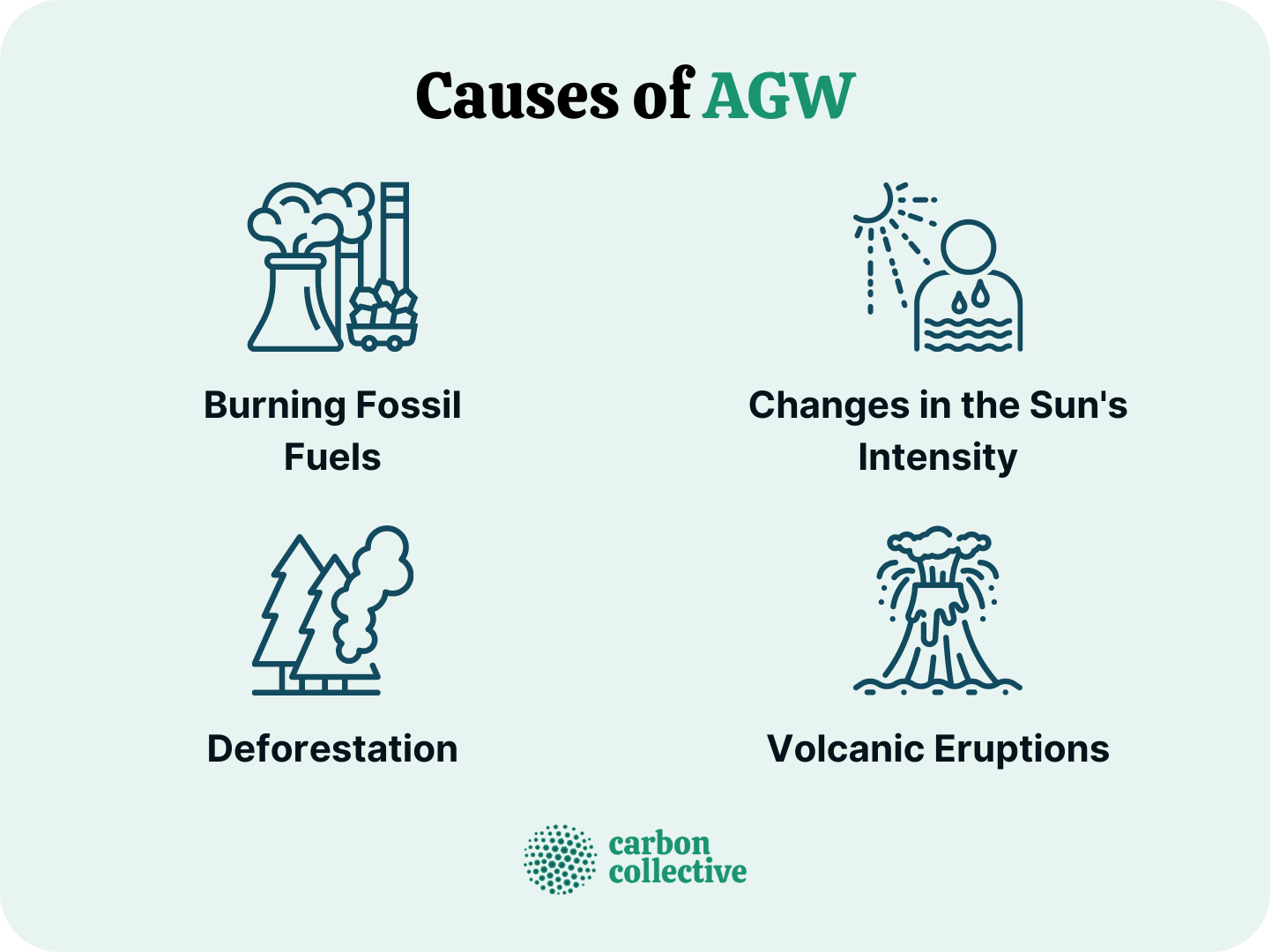What Is Anthropogenic Global Warming (AGW)?
Anthropogenic global warming is the name given to the rise in average global temperatures that is primarily attributed to human activity.
Global warming is caused by the build-up of greenhouse gases in the Earth's atmosphere. These gases form a "blanket" around Earth that traps energy from the sun.
This trapped energy makes the Earth's atmosphere warm and disturbs the Earth's climate.
These are the most common greenhouse gases emitted by human activities:
- Carbon dioxide (CO2)
- Water vapor
- Methane
- Nitrous oxide
- Chlorofluorocarbons (CFCs) and hydrofluorocarbons (HFCs)
Investing is a critical climate solution. 
The Greenhouse Effect and Its Role in Global Warming
The greenhouse effect is a natural phenomenon that helps regulate our planet's temperature. It is a process where the Earth's thermal radiation is absorbed and re-emitted by atmospheric gases, increasing the average temperature of the Earth's atmosphere.
Greenhouse gases, such as water vapor, carbon dioxide, methane, and nitrous oxide, trap heat in the atmosphere and cause the greenhouse effect.
However, human activities – like burning fossil fuels and clearing forests – have increased atmospheric CO2, which has led to greater warming of the planet, leading to an enhanced greenhouse effect and global warming.
Impact of Human Activity on the Environment
Humans have had a profound impact on the environment. Over the last two centuries, human activity has led to large-scale deforestation and widespread degradation of habitats, which have significantly impacted the biodiversity and health of the planet.
Additionally, human activity has contributed to climate change through increased greenhouse gas emissions, which have led to rising global temperatures and changes in weather patterns.
Causes of AGW
While human activity is the main driver behind anthropogenic global warming, natural causes also contribute to climate change. Listed below are some of the reasons for AGW.

Burning Fossil Fuels
The primary cause of AGW is the burning of fossil fuels, such as coal, oil, and natural gas.
Fossil fuel combustion emits greenhouse gases, like CO2, into the atmosphere. These gases trap heat within the atmosphere and cause the Earth's average temperature to rise.
Deforestation
Deforestation is another major cause of AGW. Trees and other vegetation absorb CO2 from the atmosphere and release oxygen.
However, when forests are cleared for agriculture, urbanization, or other land-use purposes, there are fewer trees to absorb atmospheric CO2. This results in more greenhouse gases in the atmosphere and contributes to global warming.
Changes in the Sun's Intensity
The sun is the primary source of energy for the Earth. However, the sun's intensity varies over time.
Studies have shown a correlation between periods of high solar activity and warm periods on Earth. Conversely, periods of low solar activity and cold periods on Earth correlate with low solar output levels.
Volcanic Eruptions
Volcanic eruptions can also contribute to AGW. When a volcano erupts, it emits large amounts of ash and sulfur dioxide into the atmosphere. These particles can reflect sunlight away from the Earth and cause cooling.
However, sulfur dioxide reacts with water vapor in the atmosphere to form sulfate aerosols over time.
These particles are much smaller than the ash and sulfur dioxide emitted by volcanoes, and they stay in the atmosphere for a longer period. These particles reflect sunlight back to the Earth, causing warming.
Effects of AGW
The effects of anthropogenic global warming are wide-ranging and varied. It is already having several adverse effects on the environment, and these include the following:
Rising Sea Levels
One of the most visible and well-documented effects of AGW is the rise in global sea levels. As temperatures increase, ice melting at the poles accelerates, causing sea levels to rise.
Rising sea levels pose a major threat to coastal communities and habitats, as they can lead to increased flooding and erosion and the loss of valuable land.
Salination of Agricultural Soils
Another significant effect of AGW is the salination of agricultural soils. As sea levels rise, saltwater intrusion into freshwater systems increases, contaminating soil and water resources.
This can damage crops and reduce crop yields, which will have a devastating impact on food production and the health of both humans and animals.
Extreme Weather Events
The increased temperature of the Earth's atmosphere is causing changes in weather patterns worldwide. These changes include more extreme weather events, such as hurricanes, floods, heatwaves, and droughts.
Increased Wildfire Risk
As temperatures continue to climb, many regions see increased fire risk. This is due to higher temperatures drying out vegetation and creating ideal conditions for wildfires to start and spread quickly.
Plant and Animal Extinctions
As environmental conditions change and habitats become degraded, species are at risk of extinction. This poses a major threat to the health and biodiversity of our planet, as many plant and animal species play an important role in ecosystems.
Ocean Acidification
Another effect of AGW is ocean acidification. As atmospheric CO2 levels rise, the oceans absorb more of the gas. This increases the level of acidity in the water, which can negatively impact marine life.
Disruptions to Food Production
The agricultural sector is already feeling the effects of AGW. Crop yields are impacted by extreme weather events, salination of soils, and ocean acidification.
This is leading to disruptions in food production and supply, as well as increases in food prices.
Human Health Impacts
AGW is also having an impact on human health. Extreme weather events can lead to injury and death, while increased air pollution and vector-borne diseases are also concerns.
Additionally, mental health problems such as anxiety and depression are rising due to the stress of living with the threat of climate change.
Mitigation & Adaptation Strategies for AGW
Mitigating Strategies
Several strategies can be implemented to mitigate the effects of AGW, including:
- Reducing carbon emissions by implementing policies that promote cleaner energy sources, such as renewable energy or nuclear power.
- Investing in research and development efforts to reduce carbon emissions from key sectors, such as transportation and manufacturing.
- Improving energy efficiency by adopting new technologies, such as smart thermostats or more efficient vehicles.
- Investing in adaptive measures, such as coastal infrastructure to protect against rising sea levels and drought-resistant crop varieties to combat drought.
Reducing Carbon Footprint
In addition to implementing strategies to mitigate the effects of AGW, it is also important for individuals to reduce their carbon footprint and promote sustainable practices that can help limit the impact of human activity on the environment.
Some ways to do this include:
- Reducing your energy use through things like turning off lights when not in use, unplugging electronics when they are not being used, and adjusting the temperature of your thermostat accordingly.
- Choosing reusable or compostable products over single-use alternatives.
- Carpooling, walking, or taking public transportation instead of driving to help reduce reliance on fossil fuels.
- Purchasing local, organic foods to support more sustainable farming practices and reduce food emissions from transport.
- Supporting organizations and policymakers working toward the goal of reducing AGW and promoting cleaner energy sources.
As the impacts of AGW continue to grow in severity, individuals, communities, businesses, and governments must work together to develop strategies for mitigating its effects and adapting to a changing climate future.
Whether through policy changes that promote cleaner energy sources or individual actions that reduce your own carbon footprint, there are several strategies you can take to help fight against AGW and help protect our planet for future generations.
Final Thoughts
Anthropogenic global warming (AGW) is a major threat to the health and biodiversity of our planet. As atmospheric CO2 levels rise, the oceans absorb more of the gas, increasing the level of acidity in the water and negatively impacting marine life.
AGW also impacts human health, with increased air pollution and vector-borne diseases being of concern. The agricultural sector also feels the effects of AGW, as crop yields are being impacted by extreme weather events, salination of soils, and ocean acidification.
To combat AGW, mitigation strategies, such as reducing carbon emissions or investing in adaptive measures, need to be implemented. Additionally, individuals can help reduce their own carbon footprint by making small changes like reducing energy use or choosing sustainable products.
Steps to fight AGW and protect our planet for future generations are achievable by working together.
FAQs
1. What is AGW?
AGW stands for Anthropogenic Global Warming and refers to the increased warming of the Earth's atmosphere due to human activity.
2. How does AGW work?
AGW works by trapping heat in the Earth's atmosphere. This happens when greenhouse gases, like carbon dioxide, are released. It then blankets the planet, trapping heat and causing its temperature to rise.
3. What are some of the causes of AGW?
Fossil fuel burning, such as coal and oil, is one of the leading causes of AGW. Other human activities contributing to AGW include deforestation, livestock farming, and agricultural practices.
4. What are some of the effects of AGW?
AGW has been linked to rising sea levels, extreme weather events, changes in climate patterns, ocean acidification and salination, increased air pollution, and many other impacts.
5. How can we mitigate the effects of AGW?
Reducing carbon emissions through energy conservation measures or switching to cleaner energy sources like solar or wind power can help mitigate the effects of AGW. Other strategies include investing in adaptive measures like coastal infrastructure or drought-resistant crop varieties.
